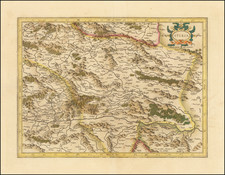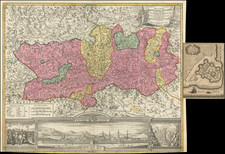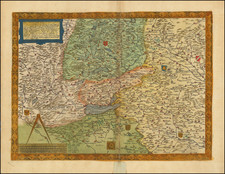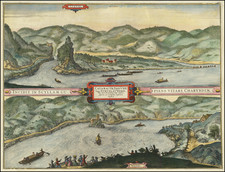Rare map of the the area around Bad Gadstein by Adolph Ritter von Skrzeszewski.
The map inclues an elaborate key detailing various establishments and natural features of the area. On the left side, there is a list labeled "Kurhäuser mit Bädern" which translates to "Spa houses with baths." It includes names such as "Solitude," "Villa Meran (private)," and several others, along with establishments like "Pfarrhaus" (parsonage) and "Armenbadhaus" (poor bathhouse).
On the right side, under "Heiße Quellen" or "Hot Springs," there is a numbered list of springs such as "Neuer 'Franz Josef' Stollen," "Fürstenstollen," and "Haupt-Stollen," among others, with indications that some are unused ("unbenützt").
The bottom of the image indicates the altitude of the Thalsolhe in Wildbad Gastein and the location of a meteorological station. Accompanying this text is a set of colored lines and symbols that likely correspond to the types of establishments and routes, including "Kurhäuser mit Bädern," "Mietshäuser ohne Bäder" (rental houses without baths), and different types of paths such as "Chaussee" (roads), "Erhaltene Landwege" (preserved country paths), and "Angelegte Fußwege" (constructed footpaths).
In the 9th century, the secluded Gastein valley was inhabited by Bavarian peasants, with subsequent Carantanian (Slavic) influence observable in the field names of its higher southern areas. Documented initially as Gastuna in a 963 deed, Gastein was part of the German stem duchy of Bavaria. It served as an alpine farming and gold mining area, situated along a key trade route in the Central Eastern Alps. Financial pressures led to the sale of the region by Dukes Otto III and Stephen I of Bavaria to the Archbishopric of Salzburg in 1297. The area's thermal springs were mentioned by the minnesinger Neidhart von Reuental in his Middle High German poem, "Die Graserin in der Gastein," around 1230. Visitors to these springs included notable figures like Renaissance physician Paracelsus and Frederick III, Holy Roman Emperor.
By the late 19th century, the therapeutic waters of Bad Gastein attracted a variety of guests, including prominent cultural and political figures. The development of skiing as a leisure activity, coupled with railroad expansion, transformed the area into a desirable destination for both affluent health tourists and the general public.













![[ Holy Roman Empire ] A Newe Mape of Germany Newly Augmented by Iohn Speed Ano Dom: 1626](https://storage.googleapis.com/raremaps/img/small/68482.jpg)
